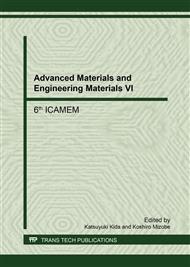p.235
p.240
p.245
p.250
p.254
p.259
p.264
p.269
p.275
Experiments of Drilling Titanium Alloy with Varying Operation Parameters
Abstract:
Drilling experiments of titanium alloy Ti6Al4V were conducted. Taking the speed and feed as the process variables, a set of experimental cutting forces are obtained and compared. From the experimental results it is concluded that within the experimental extent the thrust force and torque of drilling process rises with the feed rate. The lower spindle speed resulted in the greater amount of thrust. Feed rates have greater influence on the thrust force than the spindle speed. The combination of greater feed rate and lower spindle speed results in the maximum amount of thrust. However, combination of greater feed rate and spindle speed resulted in maximum amount of torque.
Info:
Periodical:
Pages:
254-258
Citation:
Online since:
August 2017
Authors:
Keywords:
Price:
Сopyright:
© 2017 Trans Tech Publications Ltd. All Rights Reserved
Share:
Citation:


